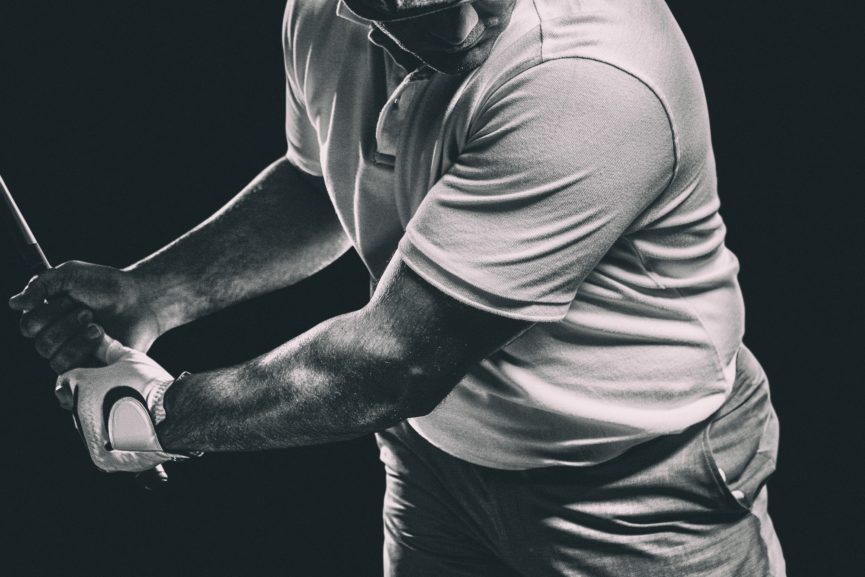Are you struggling with pain in your elbow due to a repetitive use injury? If so, you are probably wondering how it happened, what part of your elbow is causing pain, and how to find some relief from the pain. It’s possible that you are struggling with golfer’s elbow or tennis elbow.
Continue reading to learn the difference between tennis and golfer’s elbow. You’ll also discover how to get pain relief from both types of injuries.
What Is Golfer’s Elbow?
Golfer’s elbow is a type of tendonitis, also known as medial epicondylitis. The pain associated with golfer’s elbow comes from the strain on the medial epicondyle that attaches the forearm muscle to the bone on the inside of the elbow. This tendon becomes swollen and painful as a result of repeatedly twisting of the wrist, resulting in overuse.
You don’t have to be a golfer to get golfer’s elbow. These repetitive motions are also associated with:
- Gardening
- Painting
- Shoveling
- Weight training (with poor techniques)
- Working on an assembly line
- Playing sports
Golfer’s elbow is commonly diagnosed among people who are: over 40 years old, obese, smoke, or perform repetitive movements of the wrist for more than two hours per day. An individual with golfer’s elbow experiences this pain when making a fist or flexing the muscles in the forearm.
What Is Tennis Elbow?
Tennis elbow is another type of tendonitis in the elbow known as lateral epicondylitis. The lateral (outer) epicondyle tendon helps to stabilize and extend the wrist, allowing free range in the hands and fingers. The tendon becomes strained through overuse of the elbow causing pain and inflammation.
When the tendon is overused, microscopic tears form. The pain, swelling, and/or inflammation develops as a result. Nearly half of all tennis players will end up with tennis elbow at some point during their active years. However, this type of tendonitis is not exclusive to tennis players. It can also affect:
- People aged 30 to 50
- People who play other sports (baseball pitchers, football players, javelin throwers to name a few)
- Young people whose elbows are not fully developed
- People who perform manual labor via a repetitive use of lifting and turning with the wrist
Ice and inflammatory medications can help get some relief. However, medical intervention is usually necessary.
Golfer’s Elbow vs Tennis Elbow
Accurately diagnosing the type of elbow tendonitis will help to ensure that you receive the right type of treatment. Tennis elbow and golfer’s elbow tend to get confused for the other because they are so similar. Their differences are what helps to differentiate between the two.
The two types of tendonitis are similar because they are both overuse injuries that stem from tendon damage in the forearm. The pain presents in the elbow region. Though these injuries start gradually, they tend to worsen over time. These injuries can also happen to anyone, not just the sport that they’re named after.
The differences, though few, are present among these injury types. Both types of injuries affect the elbow. However, the location of the pain is different. Tennis elbow pain presents on the outer tendon outside of the elbow, while golfer’s elbow is on the inner tendon on the inside of the elbow. Golfer’s elbow may also cause numbness and tingling in the fingers of the affected hand.
Treatment Options
If you are wondering how to treat golfer’s elbow or tennis elbow, you don’t have to worry. It’s possible that you won’t even need surgery to have the tendon removed in order to correct the issue.
In fact, eighty to ninety-five percent of epicondylitis cases are able to get pain relief with non-surgical methods.
Ice and anti-inflammatories can help you find temporary relief. Physical therapy to strengthen your elbow tendons and wearing a brace while performing repetitive movements may also help you get some relief from pain.
There are two types of regenerative medicine available at Rejuvenate Your Health to promote healing: Platelet Rich Plasma therapy.
Platelet Rich Plasma Therapy
Platelet Rich Plasma (PRP) therapy enhances the body’s ability to naturally heal the injured area. PRP is a regenerative medical treatment that uses the body’s very own blood cells to promote healing and reduce pain.
It works by drawing blood from the patient before filtering out the platelets in the blood. When the platelets are separated, they can be injected directly into the injured tendon.
This type of therapy is an excellent direction of medical treatment to try before resorting to major tendon removal surgeries. With this treatment, you will still have use of your elbow and hands.
This type of regenerative medicine can reverse the natural breakdown within these tendons due to overuse and injury.
Get Pain Relief Today!
You don’t have to live with your elbow pain any longer. Whether you are having problems with golfer’s elbow or tennis elbow, we have treatment methods available to help you get the pain relief that you need.
Contact Rejuvenate Your Health today to learn more about platelet-rich plasma therapy. We want to see you getting back to the activities that you’ve been missing out on while you’ve been struggling with your injury.

